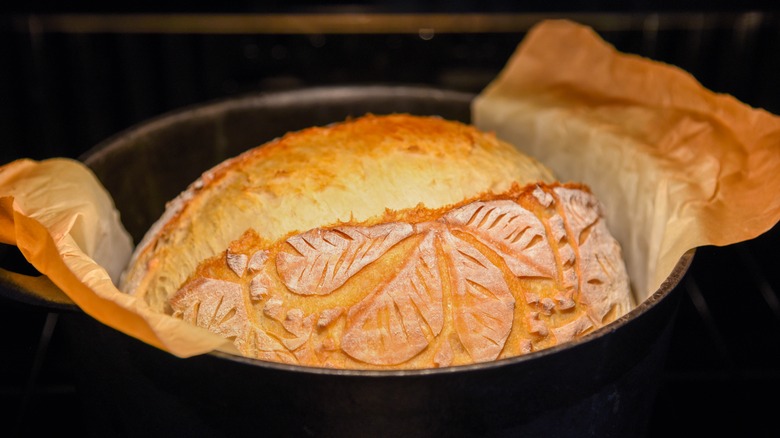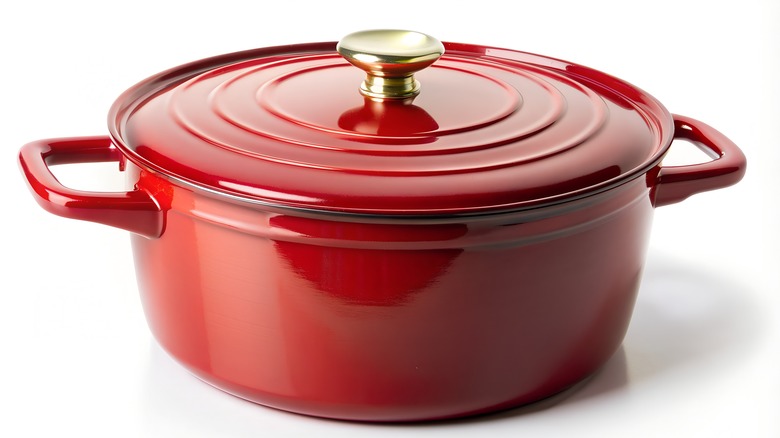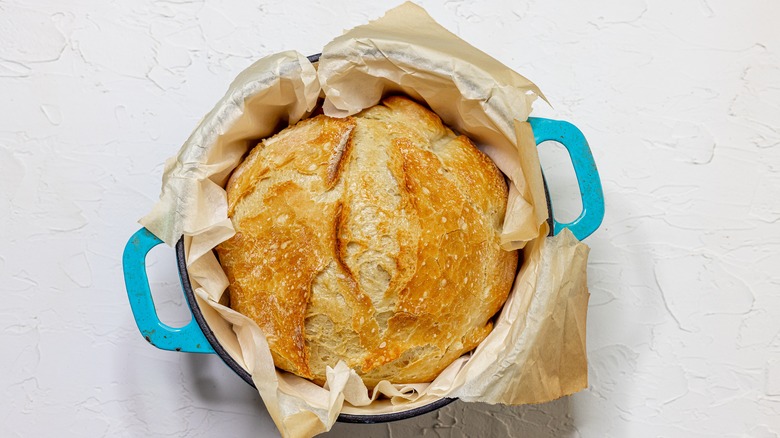The Dutch Oven Is Your Best Friend When It Comes To Easy Bread Baking
There's never been a better time to learn how to make bread. Many people in recent years have mastered the art of baking recipes like no-knead sourdough bread at home, and it's all documented on TikTok and YouTube, so it's super easy to find a tutorial to make your own loaf. If you have a Dutch oven, all the better because this versatile pot is your best friend when it comes to baking homemade bread.
Using a Dutch oven for baking bread is a lot like having a little loaf-sized steam oven inside your actual oven. The heavy cast iron absorbs heat and concentrates it into the small area inside the pot, which helps you control the temperature. At the same time, the Dutch oven traps the steam from the evaporating water in the dough as the bread rises and bakes. This combination is key for making springy bread with a crispy, chewy crust, and all you have to do is pop the lid on the pot and set a timer.
Trap the steam for springy bread
Scroll through any wedding registry, and you're bound to find a request for a Dutch oven (or a French oven), and for good reason. They're incredibly versatile tools that can handle soups, stews, and even fried chicken. They're so beloved that many cooks and chefs don't even bother to store them in a cabinet or drawer; they just leave them right out on the stovetop because they can be used for almost anything, including baking bread.
Probably the hardest part of making homemade bread is getting the heat and moisture right in the oven so that the crumb of the loaf is spongy and light while the crust is crispy. If the oven is too hot, the crust of the bread will dry out and caramelize too soon, which will keep the bread from fully rising. When you bake in a Dutch oven, the lid traps all the moisture, which will keep the crust from drying out while the bread is expanding. Most recipes recommend leaving the lid on for around 20 minutes at the beginning of the bake so that the bread can expand to its full size. Later, after the lid is removed, the crust will dry out and get brown and crunchy.
Dutch ovens concentrate the heat
Dutch ovens are also a great way to control the heat around your loaf. Most standard home ovens are only able to reach up to 550 degrees Fahrenheit, but many styles of bread like it hot — very hot. Commercial bread ovens can get much hotter than home ovens, which is how they can get consistently fluffy loaves with crispy crusts. But you can get pretty similar results using a Dutch oven. The thick cast iron of the pot absorbs the heat and concentrates it inside. Not only that, but the steam you've trapped by keeping the lid on gets it even hotter, which forces the carbon dioxide trapped inside the gluten to expand and puff up the dough. Because of this, a Dutch oven is pretty essential for baking bread if you've got an oven that is either inconsistent or just doesn't get all that hot.
But even if you have an amazing oven, a Dutch oven will make bread baking much more foolproof. Once the dough is ready to bake, pop it inside a hot Dutch oven on a piece of parchment paper (preheat it first for about 30 minutes), put the top on, and bake for 20 minutes or so. Then, take the top off, let the crust get brown, and it's time for hot, fresh bread, which is the perfect vehicle for some homemade butter made in the food processor.


